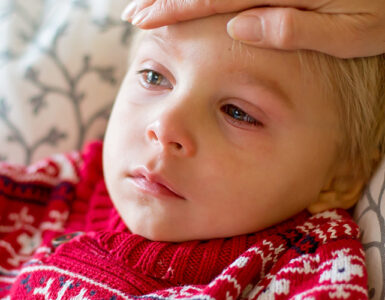Children’s visits to the emergency room are often stressful and concerning for parents. Many of these visits are due to common accidents and health issues that, in some cases, can be prevented.
Understanding the most frequent causes of ER visits can help parents and caregivers take proactive steps to prevent emergencies such as injuries, falls and head trauma.
The Most Common Reasons Children Visit the ER
More than 30 million emergency room visits for children occur in the U.S. each year. About 17 to 20 percent of all children (or one in five) in the U.S. visit the ER at least once each year.
Among the most common reasons that children end up in the emergency room include:
- Fevers and infections, including ear infections, respiratory infections, and other viral and bacterial illnesses
- Falls, such as from playground equipment, down the stairs, or from beds and other furniture at home
- Burns, including from hot liquids, steam, cooking appliances and sun exposure
- Poisoning after ingesting household chemicals, medications and even some plants
- Fractures and sprains, especially those involved in sports or other physical activities
- Cuts and lacerations, such as from cans or broken glass
- Allergic reactions, including due to food allergies, bee stings or medication reactions
8 Safety Tips to Protect Children from Emergencies
Preventative measures can reduce the risk of many incidents that lead to an emergency room visit. Here are eight ways to keep your children safe and prevent injuries, illnesses and the need for emergency medical attention:
1. Childproof Your Home
Childproofing your home is crucial for creating a safe environment where your child can explore and play without being at risk of getting hurt.
Start with the basics:
- Install safety gates at the top and bottom of the stairs
- Latch cabinets and drawers that contain harmful substances such as scissors and medication
- Make sure all heavy furniture and TVs are securely anchored to avoid tip-overs
- Keep small objects out of reach to prevent choking hazards
- Use corner protectors on sharp furniture edges
2. Supervise Water Activities
Supervision and swim safety go a long way in preventing drowning incidents, whether at home, near a pool or by any body of water. Always watch children closely when they are in or around water, even if they are proficient swimmers.
- For home pools, enforce strict safety measures like fencing with self-locking gates
- At beaches or lakes, only swim in areas that a lifeguard is monitoring
- Remove floats and toys from pools to gain a better view of children who are swimming
- Consider enrolling your child in swimming lessons from a young age to build their swimming skills
3. Monitor Your Child’s Food Intake
Parents can take several effective measures to reduce the risks of choking and allergic reactions in children:
To prevent choking:
- Supervise meal times: Make sure they sit down to eat and do not run or play with food in their mouths.
- Prepare food safely: Cut foods into small, manageable pieces for young children. Avoid giving young children hard, round or slippery foods that can block their throat easily, such as whole grapes, nuts, popcorn or hard candies.
- Teach safe eating habits: Encourage children to chew their food thoroughly and eat slowly, including when at school. Teaching them not to talk or laugh with their mouths full can also help prevent choking.
- Check toys and household items: Ensure toys and parts are appropriate for the child’s age and cannot be easily swallowed. Regularly inspect small objects within reach that could pose a choking risk.
To reduce allergic reactions:
- Identify allergens early: If you suspect your child may have an allergy, consult with a healthcare provider for testing to help avoid triggers.
- Educate on allergen avoidance: Teach children about their allergies as they grow older so they know which foods or substances they need to avoid.
- Read labels carefully: Always read food labels to check for potential allergens.
- Have an action plan: Prepare an action plan for allergic reactions, including knowing when and how to use medications like antihistamines or epinephrine auto-injectors (if prescribed).
4. Use Safe Sleeping Practices
Safe sleep practices are especially important for infants and young children who are at risk of suffocating during sleep.
- Ensure your baby sleeps in a safe position, which is on their back in a crib that’s free of pillows, blankets and toys, which can interfere with their ability to breathe.
- Children’s sleeping areas should be firm and covered with a fitted sheet.
- Dress your child appropriately in light clothing to avoid overheating, and ventilate their bedroom with open windows or a fan.
- Choose hypoallergenic materials for bedding, clothing and other products that come into contact with your child to minimize the risk of allergic reactions.
5. Install Appropriate Car Seats
Proper use of car and booster seats is essential for protecting children in vehicles.
- Make sure the car seat is appropriate for your child’s age, weight and height.
- Double-check that car seats are installed correctly according to the manufacturer’s instructions (visit a police or fire station if you need help).
- Always buckle your child into the car seat for every journey, regardless of distance.
- Avoid distractions when driving, such as checking your phone or doing anything that pulls your eyes away from the road.
6. Insist Your Child Wears a Helmet
Head injuries can be severe, but are often preventable with the proper use of helmets.
- Have your child wear a helmet when riding bicycles, scooters or skateboards, or when rollerblading or skating.
- Make sure that the helmet fits correctly and is worn consistently.
7. Teach Fire Safety
As a parent, you can limit the risk of fires happening in your home while also teaching your family what to do in case there is a fire.
- Teach your children to never play with matches or lighters.
- Keep lit candles away from children and always blow them out when leaving the room.
- Practice home fire drills so everyone knows what to do in an emergency and where to exit the house safely in case of a fire.
- Educate your children about the “stop, drop and roll” technique, which can be lifesaving.
8. Keep Up with Vaccinations and Routine Check-ups
Preventive healthcare is key to avoiding certain emergency situations.
- Keep up with your child’s vaccination schedule.
- Bring your children to regular health check-ups, which are useful for early detection and management of any potential health issues, including allergies and infections.
- If your child has an infection or illness, monitor their symptoms and contact your pediatrician for advice rather than allowing the illness to progress.
- Know the signs of issues like Lyme disease, tick bites and allergic reactions or hives, and seek help right away if your child develops symptoms.
At Stony Brook Medicine, our general pediatricians provide comprehensive primary care, including routine well and sick care for children from birth through age 21, at multiple Suffolk County locations. If you have any concerns about your child’s health, don’t hesitate to contact us for an appointment.
For more guidance on emergency services and keeping your children safe, visit the Stony Brook Pediatric Emergency Department, dedicated to providing top-tier, child-focused care.












